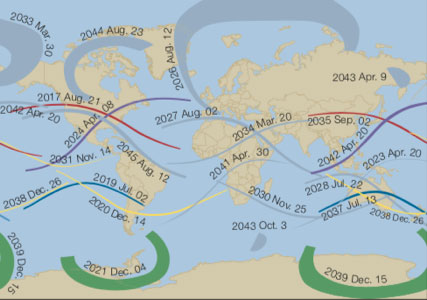Predicting Eclipses
Few phenomena have so inspired and humbled humans throughout the ages as eclipses. For many cultures, eclipses were mystical events associated with fate or the gods, and countless stories and legends surround them.
Much of the mystery of eclipses probably stems from the relative difficulty of predicting them. Look again at Figure 2.32, focusing on the two periods in which eclipses are possible, which are called eclipse seasons. If this figure told the whole story, eclipse seasons would always occur 6 months apart and predicting eclipses would be easy. For example, if eclipse seasons occurred in January and July, eclipses would always occur on the dates of new and full moons in those months. Actual eclipse prediction is more difficult than this because of something the figure does not show: The nodes slowly move around the Moon’s orbit, causing the eclipse seasons to occur slightly less than 6 months apart (about 173 days apart). As a result, instead of recurring with an annual pattern, eclipses recur in a pattern that repeats about every 18 years, 11 1/3 days, which is called the saros cycle. The map below shows total solar eclipses from 2017-2045; notice how the colored paths reveal the saros pattern.

Some ancient civilizations learned to recognize the saros cycle and therefore were able to predict when eclipses would occur. Even then, however, they could not predict all aspects of particular eclipses, including where they would be visible on Earth.
Today, we can predict eclipses with great precision because we know the details of the orbits of Earth and the Moon. Indeed, there may be no better demonstration of the power of modern science than to realize that events that frightened our ancestors can now be predicted with so much detail that we can tell you exactly when and what you’ll see in any location for any eclipse for centuries to come.